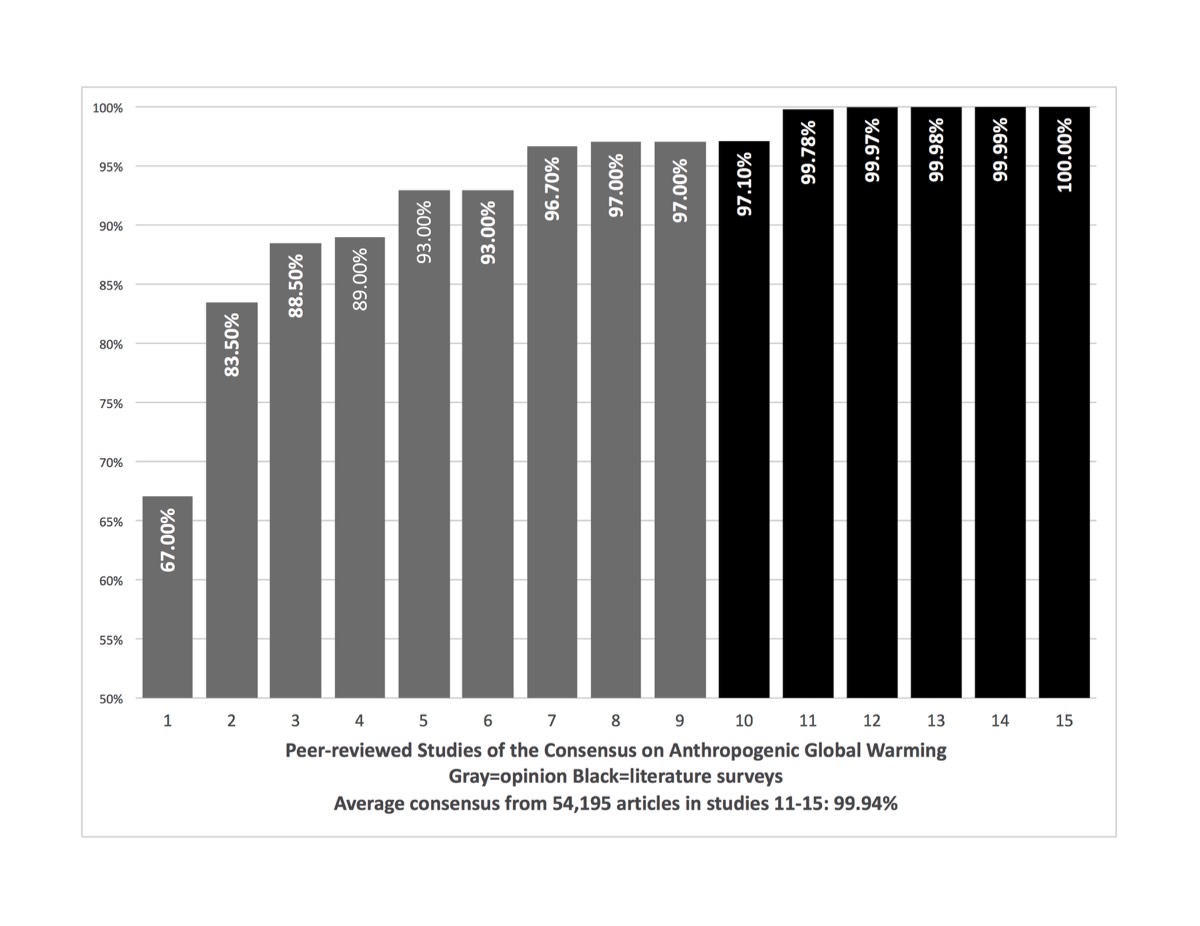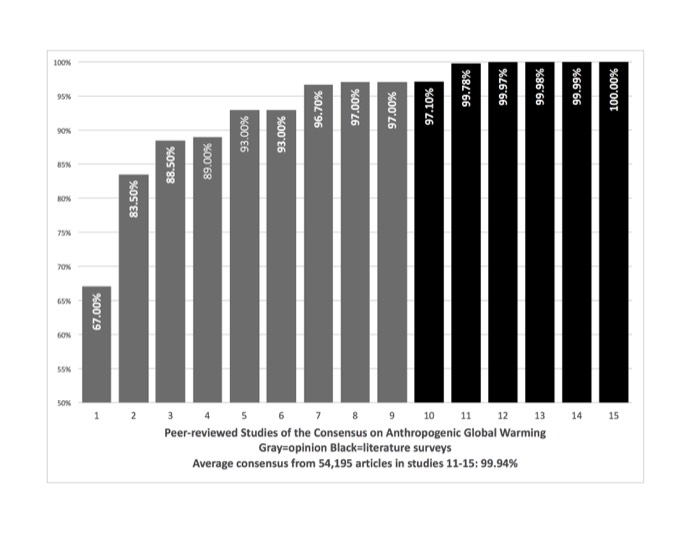
Scientists are virtually unanimous: manmade climate change is real and dangerous. Delay in preventing or at least mitigating global warming has already cost the opportunity to limit it to 2°C (3.6°F). Waiting four more years risks locking in a rise of at least 3°C (5.4°F), enough to threaten runaway global warming, the melting of the ice caps, and the ultimate destruction of civilization.
Carl Sagan wrote, "Once you give a charlatan power over you, you almost never get it back.” Last November, American voters handed humanity’s future over to a president who believes that manmade climate change is a hoax.
Some say that in his first 100 days, President Trump accomplished little other than a Supreme Court appointment. Not so. His executive orders have begun to roll back protections put in place by President Obama and other presidents back to Teddy Roosevelt. Trump has begun dismantling the Clean Power Act and the Waters of the U.S. Rule, approved the Keystone pipeline, taken steps to expand offshore drilling and withdraw protection for national monuments, approved banned pesticides, removed climate change from the EPA website, appointed climate change deniers to head key science agencies like DOE, EPA, and Interior, slashed their budgets and left hundreds of positions unfilled. And that’s just the short list.
In protest, scientists and their supporters have marched and pledged to fight on. But what if marches prove not to be enough?
Men like President Trump and his cabinet answer only to one thing: raw political power. Who has the power to confront them? Scientists. That comes as a surprise because throughout history, instead of engaging in politics, we scientists have chosen to provide the facts to guide policy-makers. But when ideology rules, politicians no longer need facts or science. For scientists to remain on the sidelines now renders us AWOL in the fight for the future of humanity.
Nearly every advance in the quality of human life is due to scientists and our partners in engineering and medicine. We have proven ourselves indispensable. No group has more potential power—if we have the courage to use it. If President Trump and his cabinet continue to ignore our marches and protest actions, we will have only one option: to strike.
Imagine that on a weekday this autumn, in towns and cities across the country, scientists, engineers, technology workers, university professors, students and all those who support science stop what they are doing and walk out of their laboratories, offices, and classrooms. Many in fields other than science, some of them already striking for their own causes, join. The strikers agree to return to work the next day, but vow to strike again and again until our government meets their demands.
To be sure, government and some private employers will retaliate. Some scientists may lose their jobs; some may go to jail. Who knows how far a president who admires Vladimir Putin and Recep Erdogan might go. However far, that may be the price of allowing future generations the right to life, liberty, and the pursuit of happiness.
What should we demand? That will require careful discussion, but I would posit first that government officials sign a pledge to base U.S. policy on the joint statement of the U.S. National Academy of Sciences and the Royal Society, that "It is now more certain than ever, based on many lines of evidence, that humans are changing Earth’s climate." Second, that science agencies have their funding and staffing restored to pre-election levels. Third, that the U.S. take whatever steps are necessary to meet its pledge under the Paris Climate Agreement and continue to show leadership on climate action. Lest these demands seem radical, they would only set the clock on climate action back to November 7, 2016. But that might be enough to give humanity a second chance.
If we wait four years to elect a president who accepts science, we may fail, as we failed last November. Even if we succeed, we cannot get back four years of climate inaction. The time is now or it may be never. What do we have to lose? Nothing but our grandchildren’s future.
pdf
Close
Carl Sagan wrote, "Once you give a charlatan power over you, you almost never get it back.” Last November, American voters handed humanity’s future over to a president who believes that manmade climate change is a hoax.
Some say that in his first 100 days, President Trump accomplished little other than a Supreme Court appointment. Not so. His executive orders have begun to roll back protections put in place by President Obama and other presidents back to Teddy Roosevelt. Trump has begun dismantling the Clean Power Act and the Waters of the U.S. Rule, approved the Keystone pipeline, taken steps to expand offshore drilling and withdraw protection for national monuments, approved banned pesticides, removed climate change from the EPA website, appointed climate change deniers to head key science agencies like DOE, EPA, and Interior, slashed their budgets and left hundreds of positions unfilled. And that’s just the short list.
In protest, scientists and their supporters have marched and pledged to fight on. But what if marches prove not to be enough?
Men like President Trump and his cabinet answer only to one thing: raw political power. Who has the power to confront them? Scientists. That comes as a surprise because throughout history, instead of engaging in politics, we scientists have chosen to provide the facts to guide policy-makers. But when ideology rules, politicians no longer need facts or science. For scientists to remain on the sidelines now renders us AWOL in the fight for the future of humanity.
Nearly every advance in the quality of human life is due to scientists and our partners in engineering and medicine. We have proven ourselves indispensable. No group has more potential power—if we have the courage to use it. If President Trump and his cabinet continue to ignore our marches and protest actions, we will have only one option: to strike.
Imagine that on a weekday this autumn, in towns and cities across the country, scientists, engineers, technology workers, university professors, students and all those who support science stop what they are doing and walk out of their laboratories, offices, and classrooms. Many in fields other than science, some of them already striking for their own causes, join. The strikers agree to return to work the next day, but vow to strike again and again until our government meets their demands.
To be sure, government and some private employers will retaliate. Some scientists may lose their jobs; some may go to jail. Who knows how far a president who admires Vladimir Putin and Recep Erdogan might go. However far, that may be the price of allowing future generations the right to life, liberty, and the pursuit of happiness.
What should we demand? That will require careful discussion, but I would posit first that government officials sign a pledge to base U.S. policy on the joint statement of the U.S. National Academy of Sciences and the Royal Society, that "It is now more certain than ever, based on many lines of evidence, that humans are changing Earth’s climate." Second, that science agencies have their funding and staffing restored to pre-election levels. Third, that the U.S. take whatever steps are necessary to meet its pledge under the Paris Climate Agreement and continue to show leadership on climate action. Lest these demands seem radical, they would only set the clock on climate action back to November 7, 2016. But that might be enough to give humanity a second chance.
If we wait four years to elect a president who accepts science, we may fail, as we failed last November. Even if we succeed, we cannot get back four years of climate inaction. The time is now or it may be never. What do we have to lose? Nothing but our grandchildren’s future.
Close
The Consensus on Anthropogenic Global Warming: 99.94%.

Studies of the consensus on anthropogenic global warming based on literature surveys give higher and more consistent results than opinion polls. Five literature surveys that used (or could have used) rejection as the criterion of consensus (11-15) agree closely. They comprise 54,195 articles from 1991-2015 and reveal an average consensus of 99.94%. I estimate that at least 150,000 individual authors wrote those articles and that does not represent all who wrote about AGW, only those found using specific search terms. (See Powell 2017, Bulletin of Science, Technology, and Society, here for free download.)
Is it not past time that, for the sake of our grandchildren's future, scientists and those who support science respond with one voice to say that on anthropogenic global warming, publishing scientists are as close to unanimous as Science gets?
Is it not past time that, for the sake of our grandchildren's future, scientists and those who support science respond with one voice to say that on anthropogenic global warming, publishing scientists are as close to unanimous as Science gets?